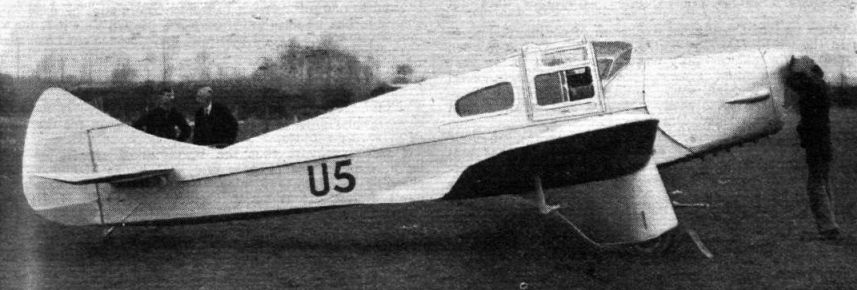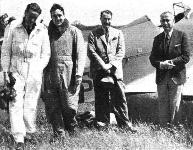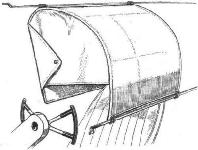
Варианты
- Miles - Falcon M.3 / Hawcon M.6 - 1934 - Великобритания
- Miles - Merlin / M.4 - 1935 - Великобритания
- Miles - Nighthawk M.7 / Mentor M.16 - 1935 - Великобритания
M.7 Nighthawk, M.16 Mentor
На основе M.3B Falcon Six спроектирован M.7 Nighthawk; построено пять гражданских самолетов. Трехместный M.7 предназначался для использования в качестве учебного и связного самолета. Затем, согласно спецификации 38/37, Министерство авиации заказало вариант самолета M.7 под обозначением M.16 Mentor - для использования в качестве связного. Mentor также предназначался для тренировок летчиков в полетах по приборам днем и ночью. Самолеты оснащались двойным управлением, радиостанцией и посадочными фарами. Прототип выполнил первый полет 5 января 1938 года, он получился тяжелее первоначального M.7, но, тем не менее, успешно прошел летные испытания, после чего поступил заказ на 45 машин. Поставки завершились в середине 1939 года.
Подобно самолету Magister, Mentor был оборудован противоштопорным дестабилизатором. После завершения программы испытаний прототипа на самолетах стали монтировать узкие рули направления, как у Magister. Войну пережил лишь один самолет Mentor, в 1947 году его продали гражданскому оператору, самолет разбился 1 апреля 1950 года.
ТАКТИКО-ТЕХНИЧЕСКИЕ ХАРАКТЕРИСТИКИ
Miles M.16 Mentor
Тип: трехместный учебный и связной самолет
Силовая установка: один мотор жидкостного охлаждения de Havilland Gipsy Six мощностью 200 л. с.
Летные характеристики: максимальная скорость на уровне моря 251 км/ч; практический потолок 4200 м
Масса: пустого 897 кг; максимальная взлетная 1229 кг
Размеры: размах крыла 10,61 м; длина 7,98 м; высота 2,95 м; площадь крыла 16,81 м2
Описание:
- M.7 Nighthawk, M.16 Mentor
- Flight, February 1936
LEARNING in LUXURY
Фотографии
-
Flight 1936-02 / Flight
The new Miles Nighthawk has an ingenious arrangement of hoods by which the pupil is prevented from seeing the horizon, although he can see, and fly by, the instruments fitted to the dash. The instructor retains a very wide angle of view. In the spring the Nighthawk will become available as a luxurious four-seater.
-
Flight 1936-02 / Flight
The doors of the Nighthawk are designed with a view to quick exit in an emergency.
-
Flight 1936-02 / Flight
This is the prototype Nighthawk, with a Gipsy Six engine, prior to being tested by Mr. Miles.
-
Air Enthusiast 1996-05 / Round-Out
Регистрационный номер: G-AGWT [5], VP-KMM [5], VR-TCM [5] Miles Nighthawk G-AGWT part of Noel Collier’s happy memories of Woodley. Hugh Kendall was the pilot for a 7/6d joyride!
-
Jane's All the World Aircraft 1980 / Encyclopedia of Aviation - Aircraft A-Z - v4
Регистрационный номер: G-AGWT [5], VP-KMM [5], VR-TCM [5] Miles M.7A Nighthawk.
-
Aeroplane Monthly 1990-08 / Personal album. Civil
Регистрационный номер: G-AGWT [5], VP-KMM [5], VR-TCM [5] The sole Miles M.7A Nighthawk photographed on a flight from Redhill on October 3, 1948 lan Forbes is probably the pilot. G-AGWT was put together in 1944, using the wings of a Miles Mohawk and a Miles M.7 Nighthawk fuselage. Powered by a 205 h.p. D.H. Gipsy Six Series II engine, the aircraft received its C of A on March 15, 1946. It was used by Raceways Ltd, an air taxi company based at Woodley. Following a period in Kenya as VP-KMM, the M.7A returned to the UK in August 1961 as VR-TCM.
-
Aeroplane Monthly 1987-05 / M.Hardy - Redhill recollections (2)
Регистрационный номер: G-AGWT [5], VP-KMM [5], VR-TCM [5] The Miles Nighthawk G-AGWT snapped at Redhill in September 1952. Painted cream with red lettering, 'WT was erected in 1944 and had Mohawk wings. In 1963 it was abandoned at Lignane, near Aix-en-Provence, on a flight out to Singapore.
-
Flight 1936-07 / Flight
Phillips and Fowis were represented by the Hawk Trainer, the Nighthawk, and the Miles Whitney Straight, all fitted with Gipsy engines.
Другие самолёты на фотографии: Miles Hawk / M.2 - Великобритания - 1932Miles Whitney Straight / M.11 - Великобритания - 1936
-
Мировая Авиация 194
Учебный и связной самолет Miles M.7 Nighthawk спроектирован на основе Falcon M.3B Six.
-
Flight 1936-02 / Flight
SPIN-STOPPING BY PARACHUTE: Mr. F. G. Miles has evolved a scheme, not yet tested in actual flight, for stopping a flat spin during the flight-testing of new aircraft by releasing a small parachute anchored to the tail of the machine. In this picture the parachute is being fitted on a Nighthawk.
-
Flight 1936-06 / Flight
A Miles Nighthawk training aircraft will be among the "new and experimental" types. The 130 h.p. Gipsy Major and 200 h.p. Gipsy Six are alternative power plants.
-
Air-Britain Archive 1983-01
Регистрационный номер: VR-TCM [5], G-AGWT [5], VP-KMM [5] Miles Nighthawk VR-TCM features below as G-AGWT to which it was restored in 1962, prior to which it was photographed at Redhill wearing Proctor spats.
-
Мировая Авиация 194
Регистрационный номер: L4393 На момент начала войны в британских ВВС имелось 12 самолетов M.16 Mentor. Они использовались как учебные и связные в 24-й эскадрилье и некоторых других подразделениях.
-
Aeroplane Monthly 1979-07 / Hooton Park /Gone but not forgotten/ (3)
Регистрационный номер: L4396 Miles M.16 Mentor L4396 of No 24 Communications Squadron at Hooton in 1938.
-
Flight 1938-06 / Flight
Регистрационный номер: L6846 The Miles Nighthawk in which Capt. Balfour, Under-Secretary of State for Air, toured a number of stations.
-
Air-Britain Archive 1984-01
Регистрационный номер: G-AHKM The only civil M.16 Mentor G-AHKM, c/n 462, with a crudely-painted '3' on the rudder. It was written off on 1.4.50
-
Flight 1936-02 / Flight
The duplication of the instruments, the layout of the swing-over controls and the method of screening a pupil are all apparent in this sketch. The hood slides on rails.
-
Flight 1936-02 / Flight
This Flight sketch shows the hood which can be unbuttoned and slid back.
-
Flight 1937-11 / Flight
Designed to be used either as a charter type or as specialised trainer, the Miles Mentor carries four people and their luggage. The outline is characteristically "Milesian" both in plan and elevation. Its cruising speed is 149 m.p.h.
- Фотографии


















